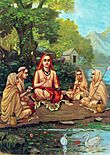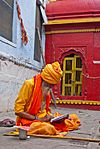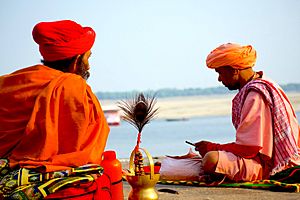Moksha facts for kids

Moksha is a very important idea in some parts of Hinduism. It is seen as the main goal for a person's spiritual journey. In the ancient Sanskrit language, "moksha" means "freedom" or "liberation." It is similar to the idea of Nirvana in Buddhism.
What is Moksha?
According to some Hindu teachings, life is like an endless cycle. This cycle includes being born, living, dying, and then being born again. This happens in a physical world that is sometimes seen as an illusion. Moksha is about breaking free from this cycle. It means reaching a state of lasting peace and happiness. This state goes beyond all the joys, pains, and feelings of the physical body.
How to Reach Moksha
Many Hindus try to achieve Moksha. They believe they can find this freedom from the material world through different types of Yoga. These paths include:
- Jnana Yoga: This path focuses on gaining true knowledge and understanding.
- Karma Yoga: This path is about doing good actions without expecting a reward.
- Bhakti Yoga: This path involves showing devotion and worship to God through prayers and rituals.
History of Moksha
The idea of Moksha comes from ancient Hindu texts called the Vedas. Scholars believe that Moksha in Hinduism and Nirvana in Buddhism are connected. They share similar ideas and have a close history. You can also find ideas similar to Moksha in the Upanishads, which are important Hindu scriptures.
Images for kids
-
Gajendra Moksha (pictured) is a symbolic tale in Vaishnavism. The elephant Gajendra enters a lake where a crocodile (Huhu) clutches his leg and becomes his suffering. Despite his pain, Gajendra constantly remembers Vishnu, who then liberates him. Gajendra symbolically represents human beings, Huhu represents sins, and the lake is saṃsāra.
-
Mokṣha is a key concept in Yoga, where it is a state of “awakening”, liberation and freedom in this life.
See also
 In Spanish: Moksha (hinduismo) para niños
In Spanish: Moksha (hinduismo) para niños







